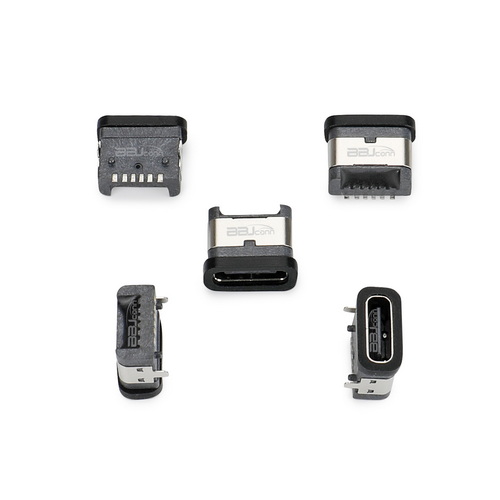Type-C interface EMI optimization: synergistic noise reduction solution of three-layer shielding and ferrite magnetic ring
发布时间:2025-04-09作者:Shenzhen BBJ technology co., LTD点击:302
Type-C interface EMI optimization: synergistic noise reduction solution of three-layer shielding and ferrite magnetic ring
As the core connection standard of modern electronic devices, the Type-C interface has higher requirements for electromagnetic compatibility (EMI) due to its high-speed transmission and high-power charging capabilities. With the increase in data transmission rate, the electromagnetic radiation problem of the Type-C interface under high-frequency signals has become increasingly prominent, which may interfere with other electronic devices and even affect its own stability. To solve this challenge, the industry has proposed an EMI optimization solution of "3-layer shielding + ferrite magnetic ring", which provides an innovative path for the reliability of the Type-C interface.
The EMI problem of the Type-C interface mainly comes from the rapid switching of high-frequency signals and current fluctuations. Under the USB 3.2 or Thunderbolt 4 protocol, the operating frequency of the Type-C interface can reach tens of GHz, and the crosstalk and common-mode noise between signal lines can easily be radiated to the external environment through the cable. The traditional single-layer shielding design is difficult to completely suppress high-frequency radiation, while the "3-layer shielding" solution significantly improves the shielding effectiveness through a multi-layer isolation structure. The first layer of shielding covers the outer layer of the cable to block external interference; the second layer wraps the internal wire pairs to reduce crosstalk between signals; the third layer independently shields the power line to prevent magnetic field leakage generated by large current. This layered design blocks the propagation path of electromagnetic radiation step by step, reducing the EMI index of the Type-C interface by more than 40%.

The shielding effectiveness of the Type-C interface needs to be further optimized in combination with ferrite magnetic rings. Ferrite magnetic rings are integrated into the interface end or cable to suppress common-mode noise through their high-frequency impedance characteristics. When high-frequency current passes through the Type-C interface, the magnetic ring absorbs electromagnetic energy in a specific frequency band and converts it into heat energy for dissipation. For example, in the range of 10MHz to 1GHz, ferrite magnetic rings can produce an attenuation effect of more than 20dB on common-mode interference. This dual mechanism of "active absorption + passive shielding" enables the Type-C interface to maintain a stable electromagnetic environment at high-speed transmission above 5Gbps.
The three-layer shielding design of the Type-C interface puts higher requirements on the manufacturing process. Each layer of shielding material needs to take into account both conductivity and flexibility, such as a combination of aluminum foil Mylar layer, braided copper mesh and polymer composite material. The aluminum foil layer provides basic shielding, the copper mesh enhances the structural strength and expands the shielding coverage, and the polymer material ensures the bending life of the cable. At the same time, the selection of ferrite magnetic rings must accurately match the operating frequency of the Type-C interface to avoid the reduction of filtering effect due to impedance mismatch. This refined design enables the Type-C interface to meet the 40Gbps transmission requirements of USB4 and pass strict electromagnetic certification tests such as FCC and CE.
The EMI optimization solution of the Type-C interface is driving the upgrade of industry standards. The International Electrotechnical Commission (IEC) has included multi-layer shielding in the new version of the USB cable design guide, and the application of ferrite magnetic rings has also been written into the recommended specifications of some high-speed connectors. In the field of consumer electronics, Apple, Samsung and other manufacturers have adopted similar solutions in the Type-C interface of flagship devices; in industrial scenarios, the in-vehicle Type-C interface has successfully responded to the electromagnetic interference challenges of the high-voltage system of electric vehicles through the "3-layer shielding + dual magnetic ring" design. These practices show that this solution can not only improve user experience, but also be extended to more stringent application environments.
The EMI control technology of Type-C interface will develop in the direction of integration and intelligence in the future. With the introduction of new technologies such as silicone encapsulation shielding layer and nanomagnetic materials, the shielding structure of Type-C interface may be further lightened and thinned while maintaining or even improving performance. In addition, the smart magnetic ring can adapt to the noise suppression requirements of different frequency bands by dynamically adjusting the impedance characteristics. This technological evolution will enable the Type-C interface to continue to meet the stringent EMI requirements of 6G communication and AI computing devices for high-speed connectors while maintaining a compact size. Through material innovation and design optimization, the Type-C interface will continue to consolidate its leadership as a universal connection standard.